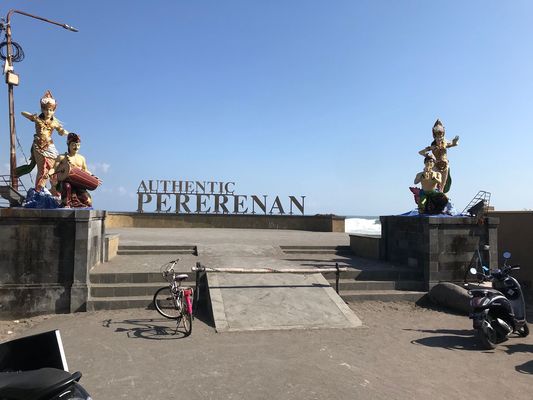
By Phil Jarratt
Back in Bali last weekend for the first time in nine months, I was gob-smacked by the speed of development in my absence in the once-peaceful village that we have called home these past eight or nine years.
Since the early ‘80s, when the motor bike noise and the proliferation of Aussie yobbo sports bars forced us out of Kuta Beach, “progress” has sent us looking for a new quiet corner every few years, so I shouldn’t really be surprised. From Kuta we moved up the beach to Sunset Cottages in Tuban until the frequency of flight arrivals went from a few a day to a few every five minutes, so then we joined the growing band of hedonists renting little places in the jungle near the Blue Ocean Bar in an untouched village called Seminyak.
In the ‘90s we found Umelas, where we briefly leased a lovely piece of land by the river and were the only bules (Westerners) in the village. After the bombings we found that Canggu, a place in the rice fields where I’d surfed since the ‘70s, now had some accommodations and a few places to eat, and when that got too intense, we moved again, across another river to the last remaining peaceful village on the Badung coast.
I’ve written about it often, in these pages and elsewhere, and I’ve always been coy about naming it, for fear of unleashing the next torrent of construction and traffic. But the game is up. Last Saturday I walked down the Jalan Pantai past dozens of new buildings and dozens more under construction along the road that used to delight us with its rice field panoramas and glimpses of the distant mountains.
When I arrived at the beach to check the surf I found that the view of my favourite lefthander was completely blocked by a monstrous concrete platform featuring statues of traditional dancers and musicians, beyond which a huge wrought iron sign announces “AUTHENTIC PERERENAN”, which ironically it was until they went berserk on a building bender.
I’ve always taken the view that some concepts are best left to the eye of the beholder, and if you have to announce that you are authentic, you almost certainly no longer are. So here we go again. Maybe we’ll extract another year of pleasure out of Pererenan, but the writing is on the wall – literally – and as it happens I know another pretty little left-breaking wave about an hour away, where you can still walk through the paddies and see the fireflies at sunset.
And no, I’m not telling.
The writing on the wall
Speaking of writing on walls, in Timor-Leste last week we hired the services of four young artists from the country’s only art school, Arte Moris, who spent four days painting the story of our film on the wall of the headquarters of a human rights organization, cleverly dodging air con units and office windows. I loved the raw energy of the work, and of the talented young men, barely out of their teens, who worked every daylight hour, usually watched by a gallery of enchanted onlookers.
Since it opened in 2003 in a vast premises that had once been an Indonesian-built anthropological museum, then a UN hospital during the violence of 1999, Arte Moris has nurtured just about all of Timor-Leste’s leading artists, musicians and writers of the new century. Encouraged by then President Jose Ramos-Horta, Swiss artists Luca and Gabi Gannser, and Timorese artists Iliwatu Danabere founded the free fine arts college and opened its grounds to starving artists to build studios, accommodations, tattoo parlours and rehearsal spaces.
Today, the grounds of Arte Moris have run wild, installations lie broken alongside dead cars, the paint has peeled from the ceilings, and yet from out of this chaos and craziness, the vision of Luca Gannser, who died a month ago, has been fulfilled. The country’s two leading bands, Galaxy and Klamar, were formed on the premises and still call it their spiritual home.
Our lead mural artist, Evangelino Manuel Peroira (known as Evan), ran away from home at 12 a decade ago and has lived at Arte Moris ever since. He now has a degree in architecture and travels the region as a teacher of street art. Stories like his are common.
Successive Timorese governments have chosen to buy Toyota Prados by the score rather than support the arts, and yet Arte Moris manages to survive, and its wild spirit thrives.








